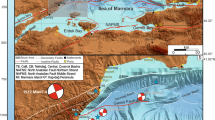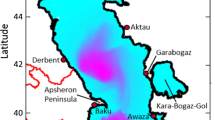Abstract
A sequence of computer experiments is used to study questions concerning the tsunami problem as a quantitative estimate of tsunami danger, detailed geographical tsunami classification, determination of the parameters of ‘critical’ tsunami waves, and the conditions of their development. We call a wave ‘critical’, if its impact on the coast is most hazardous.
Using the Middle Kuril Island as an example, we present the results of a computer experiment which includes determining the wavefields on the shelf and estimating the effects connected with the deep-water Bussol and Diana Straits.
Numerical simulation of tsunami waves of different sources permits the assessment of the extent of tsunami danger in different areas of the coastal zone of Simushir Island, depending on the location of the focus zone and their geometry.
The major singularities of the wavefield arise in the zones of the deep-water straits. The distribution of the amplification factors is determined by both the global parameters of the wavefields and the local properties of individual harbours. The results obtained for a particular harbour in the northern part of Simushir Island, formed the basis for the quantitative estimate of tsunami danger for this area.
Similar content being viewed by others
References
Go, C. N., Kaistrenko, V. M., and Simonov, K. V.: 1982, The local long-term forecast of tsunami and tsunami zoning, Preprint, Sakh KNII, Sakh KNII DVNTs, Yuzhno-Sakhalinsk.
Kaistrenko, V. M., Pelinovskii, E. N., and Simonov, K. V.: 1985, The wash and trasnformation of tsunami waves on shallow water, Meteorologija i gidrologija, No. 10, 68–75.
Go, Ch. N., Kaistrenko, V. M., and Simonov, K. V.: 1985, A two-parameter scheme for tsunami hazard zoning, Marine Geodesy, 469–476.
Marchuk, An. G., Chubarov, L. B., and Shokin, Yu. I.: 1985, Numerical modelling of tsunami waves, Los Alamos National Laboratory, University of California, LA-TR-85-40.
Alekseev, A. S., Gusiakov, V. K., Chubarov, L. B., and Shokin, Yu. I.: 1983, Numerical simulation of the Shikotan Tsunami, Proc. 1983 Tsunami Symposium. Hamburg, pp. 249–250.
Solovyov, S. L.:1972, Earthquake and tsunami recurrence in the Pacific Ocean, In Volni tsunami, Tr. Sakh. KNII, Yuzhno-Sakhalinsk, 29.
Dikhan, B. D., Zhak, V. M., Kulikov, Ye. A., et al.: 1981, The first registration of tsunami in the ocean (South Kuril Tsunami, 23.02.80), DAN, 257(5), 1088–1092.
Chubarov, L. B., and Gusiakov, V. K.: 1985, Tsunami and earthquake mechanisms in the islands arc regions, Science of Tsunami Hazards, 3(1), 3–21.
Fain, I. V., Shevchenko, G. V., and Kulikov, Ye. A.: 1983, The investigation of the edge waves on the Kuril Shelf by the ray method, Okeanologia No. 1, 23–26.
Pelinovskii, Ye. N.: 1982, Nonlinear Dynamics of the Tsunami Waves, IPF AN SSSR, Gorky.
Yefimov, V. V., Kulikov, Ye. A., Rabinovich, A. B., and Fain, I. V.: 1985, Ocean Boundary Waves, Gidrometeoizdat.
Groshev, Ye. B., Marchuk, An. G., and Chubarov, L. B.: 1986, Propagation of tsunami wave from sources lying close to the shore, Tsunami Wave Researches, No. 1. Generation and Propagation in the Ocean of Tsunami Waves. Moscow, pp. 94–101.
Marchuk, An. G., Chubarov, L. B., and Shokin, Yu. I.: 1983, Numerical Modeling of Tsunami Waves, Nauka, Novosibirsk.
Averyanova, V. N.: 1975, The Deep Seismotectonik of the Islands Arcs, Nauka, Moscow.
Solvyov, S. L.: 1978, The basic tsunami-data for the USSR Pacific coast, 1737–1976, in Izuchenie tsunami v otkrytom okeane. Nauka, Moscow, pp. 61–136.
Solovyov, S. L.: 1965, The Kuril (13–20,10. 1963) Earthquake and Tsunami, Yuzhno-Sakhalinsk.
Fedotov, S. A.: 1968, The long-term seismical forecast for the Kuril-Kamchatka region, in Problema tsunami, Nauka, Moscow, pp. 121–139.
Bilhan, R. 1983, Tsunami-resistant gauges for epicentral sea level studies, Proc. 1983 Tsunami Symposium, Hamburg, pp. 155–175.
Fain, I. V. 1984, Frequency properties of the Kuril shelf, in Generatsia tsunami i vykhod na bereg, Radio i svyaz, Moscow, pp. 80–83.
Solovyov, S. L., Nekrasov, A. V., Bukhteev, V. G., and Pyaskovskii, R.: 1977, Preliminary tsunami pinpointing on the Kuril-Kamchatka shore, based on hydrodynamical calculations, in Teoreticheskie i experimentalnye issledovania po probleme tsunami, Nauka, Moscow, pp. 131–139.
Author information
Authors and Affiliations
Rights and permissions
About this article
Cite this article
Chubarov, L.B., Shokin, Y.I. & Simonov, K.V. Using numerical modelling to evaluate tsunami hazard near the Kuril Island. Nat Hazards 5, 293–318 (1992). https://doi.org/10.1007/BF00125233
Received:
Revised:
Issue Date:
DOI: https://doi.org/10.1007/BF00125233




